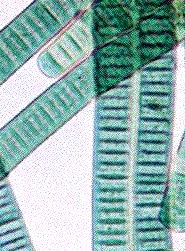Cyanobacteria are aquatic and photosynthetic. They inhabit water environments and manufacture their own food. As bacteria, they are very small and usually unicellular, though they often grow in colonies large enough to see with the unaided eye. They may be the oldest known fossils, more than 3.5 billion years old. The cyanobacteria are still around after millions of years. They constitute one of the largest and most important groups of bacteria on earth.
|
|
 |
Many of today's oil deposits are attributed to the activity of cyanobacteria. They are important providers of nitrogen fertilizer in the cultivation of rice and beans. The oxygen atmosphere that we depend on was generated by numerous cyanobacteria during the Archaean and Proterozoic geologic eras. Before that time, the atmosphere was considered to be a reducing atmosphere without much, if any oxygen.
The other great contribution of the cyanobacteria is the origin of plants. The chloroplast of higher plants may actually be a cyanobacterium living within today's plant's cells. Sometime in the late Proterozoic, or in the early Cambrian, cyanobacteria began to become symbiotically associated with certain eukaryotic cells, making food for the host cell in return for a viable habitat. This hypothesis is known as the endosymbiont hypothesis, and may also be the mechanism of the origin of the eukaryotic mitochondrion.
Cyanobacteria are often called the blue-green algae because they are photosynthetic and aquatic, but they have no kinship to the algae. Cyanobacteria are relatives of the bacteria, not eukaryotes, and it is only the chloroplast in eukaryotic algae to which the cyanobacteria are related.
